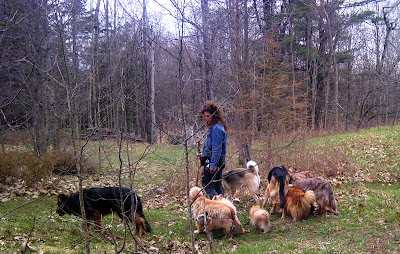TEACH YOUR DOG NOT TO BARK & BEG FOR FOOD
Did you teach it to do
this as a little trick? Did your dog just start this own its own? Or perhaps
the dog is a rescue and this is a behavior that the dog already had. Or maybe
your dog is a rescue and has been traumatized in the past by not receiving food
on a regular basis.
No matter what the
reason, you might find this behavior to be kind of cute and endearing at
first. But, unless you have also taught your dog the threshold - the limit, when
to stop…this behavior can be:
-
Habit forming;
-
May escalate to dominating, reactivity, anxious, neurotic behavior;
If this happens, it can really get you irritated, which will make the dog more anxious
= psychological damage to your dog and to you.
Yeap, not so good and definitely not cute any more!
SO WHAT SHOULD YOU DO TO STOP THE BEHAVIOR?
FIRST LET’S TALK ABOUT THE PSYCHOLOGICAL SIDE OF
THINGS.
When your dog demands attention and rewards (whether
food, affection, toys, etc.) your dog is taking control of the situation - this
is not good, as you have just surrendered control of the situation to your dog
and in so doing have lost some of his respect for you as a leader. Please take
note this is not the same as when your dog looks at you for direction…in this
case your dog is not asking he is telling!
If your dog is a rescue, underweight or overweight and you feel
sorry for him, you are adding and abetting this bad habit. Stop feeling bad for
your dog - this undermines his self confidence and can make him anxious and if
your lack of leadership continues your dog can become aggressive reactive…pushiness
can grow exponentially!
If you are starting to feel annoyed or frustrated
with your dog, you are only going to increase his will to bark. Your lack of
control of your emotions reinforces his understanding that you are not in
control of the situation. More reason for him to take over! If you yell at your
dog to stop barking - you are barking too, and that is leading by the wrong
example.
Please do not say to your dog ‘would you just stop
that!’ or I wish you would stop doing that’, or ‘you are bothering me, quite
it!’ If you do this you are not providing direction, nor are you embracing the
role of leader. You are whining and complaining not providing direction! When we
whine instead of direct, we give our dog a choice - you can listen to me or
not. Just like humans, most will choose the ‘not’ option.
Before you read any further - read these two articles.
They will only take you a few minutes to read - but will really improve your
understanding of how dogs assign respect to their humans and how our state of
being can either work for us or against us in our endeavor to direct our dogs.
SO WHAT SHOULD YOU DO?
Train yourself, coach and mentor your dog. If you
ask the right way your dog will listen - he does not need to be trained…but you
do! Get your emotional state under control, engage your working mode on and let’s
go.
Before you attempt to direct your dog…set your
expectations…
First - remember that your dog has been doing this
for awhile - I have the experience to make change immediate, you probably do
not so be patient. Be calm, be deliberately confident, be assertive but fair,
and have the expectation in your mind that your dog will listen. You need to be
consistent, persistent and100% committed to the direction you provide (your dog
knows when your are not!). Your will must be stronger than your dogs.
Be prepared to give a full instruction. A full instruction
consists of:
1.
Getting your dogs attention;
2.
Telling him what you do not what him to do;
3.
Telling him what you do want him to do instead, and;
4.
Following through to correct him
if he backslides into the unwanted behaviour.
The leadership role is one of coaching and mentoring
with fair, firm, clear direction. Never match your dog’s state but you do have
to match the intensity of his behaviour. I see a lot of people doing only step
2. Then the poor dog gets in trouble as it goes back to doing the unwanted
behaviour as its human has not provided a full set of instructions! Blame yourself,
not your dog!
Firstly, if you dog barks you have to disagree right
away. If you wait and then address your dog he will not understand what you are
disagreeing with. To disagree with the bark you can:
-
Say ‘shh’ or ‘no’;
-
Snap your fingers;
-
Or quickly tap your fingers once against your dog’s waist or neck to get his/her attention and say ‘no’, 'uh' or ‘shh’ - and please never touch your dog in this way if you are angry, the point if not to punish your dog, the point is simply to get your dog's attention focused back on you polity and respectfully.
Remember that the energy
behind the direction is everything. Your emotions must
be disengaged, you
must be calm, assertive-confident, never angry, frustrated etc.
Secondly, your dog should not be in your food prep space.
When your dog learns to sit and relax quietly you can relax the rule, but for
know he needs to exit stage left! The approach you take to communicate to your
dog should depend on the sensitivity level of your dog. Some dogs see touch as
an engagement to converse, be excited. Other dogs see voice as engagement.
Engagement gives the dog the opportunity to argue and debate the situation with
you - that is not what you want. You want to disengage and direct.
If your dog is very sensitive pointing your finger
and calmly saying ‘out’ may be enough. If your dog is less sensitive and fully
committed to perusing his course of action you need to intensify your direction
to him.
The best method is to simply use your body to herd
your dog out of the space and then show him where you want him to sit/lie down.
This is using dog language rather than human language - a very clear and
effective way to communicate. If your dog gets up simply herd him back to the
desired location. It is better not to talk, touch or look - just herd.
If your dog begs for food, you can use the same technique to discourage the begging.
Remember that when we develop a habit it takes time, effort and commitment to get rid of the habit...affecting change may take hours, days, weeks or more.
So to with dogs.
Further, your strength as a leader and affective communicator will
determine how quickly the behaviour can be turned around. I can affect change
immediately because I have trained myself to be aware, I use instinct and
intuition and have a lot of experience working with dogs in all states of
being. You will have to be patient and fair with yourself and your dog to
achieve success as your experience is less comprehensive. Not to worry, just
boost your commitment to achieving your goal and you will move along at a good
pace.
Additional Assistance
Holistic Wellness and Behaviorist Services
Do you need holistic advice to support your companion animal's health and well being? Become a client. Book your consultation. My professional holistic nutrition, wellness and behavioral services are available to you:
🌿 Holistic Wellness Services for Dogs and Cats 🐕 🐈
🌿 Holistic Behaviorist Services for Dogs 🐕
My Holistic Client Services are Available Worldwide:
🇺🇸 USA
🇨🇦 Canada
🇬🇧 UK and other European countries
🇦🇺 Australia and other Oceania countries
🇭🇰 Hong Kong and other Asian countries
🇨🇷 Costa Rica and other Central American countries
🇪🇺 European countries
🇹🇹 Trinidad and Tobago and other South America countries
🇿🇦 South Africa and other African countries
🇸🇪 Sweden and other Nordic countries
🇦🇪 United Arab Emirates
Available Holistic Consultations and Sessions:
📱 FaceTime
📱 Facebook video or voice calling
💻 Skype
Do you need holistic advice to support your companion animal's health and well being? Become a client. Book your consultation. My professional holistic nutrition, wellness and behavioral services are available to you:
🌿 Holistic Wellness Services for Dogs and Cats 🐕 🐈
🌿 Holistic Behaviorist Services for Dogs 🐕
My Holistic Client Services are Available Worldwide:
🇺🇸 USA
🇨🇦 Canada
🇬🇧 UK and other European countries
🇦🇺 Australia and other Oceania countries
🇭🇰 Hong Kong and other Asian countries
🇨🇷 Costa Rica and other Central American countries
🇪🇺 European countries
🇹🇹 Trinidad and Tobago and other South America countries
🇿🇦 South Africa and other African countries
🇸🇪 Sweden and other Nordic countries
🇦🇪 United Arab Emirates
Available Holistic Consultations and Sessions:
📱 FaceTime
📱 Facebook video or voice calling
💻 Skype
📱 WhatsApp
📞 Phone
📧 Email
🚶🏻♀️ In-Person
Menu of Holistic Wellness Services for Dogs and Cats 🐕🐈
For more information go here.
✅ Maintain Health, and;
✅ Address Health Issues and Conditions:
✓ Treatment and Remedy
✓ Pre-Surgery holistic support protocols
✓ Post-Surgery holistic healing protocols
✓ Pre-Vaccine holistic support protocols
✓ Post-Vaccine holistic support protocols
✓ Natural Insect and Parasite Prevention
✓ Natural Treatment for Insect, Parasite Infestation, Co-Infection, Disease
✅ Custom Designed Whole Food Diets - raw or gently cooked, and;
✅ Advice and Recommendation:
✓ Premade Diets - raw, dehydrated, freeze dried
✓ Supplemental Fresh Foods - raw, gently cooked
✓ Super foods
✓ Treats - raw, dehydrated, freeze dried, gently cooked
✓ Herbs
✓ Alternative Medicines
Menu of Holistic Behaviorist Services for Dogs 🐕
For more information go here.
In-person Sessions - available locally
Voice and Video Sessions - available worldwide
✓ Obedience Training
✓ Behavior Modification
✓ Psychological Rehabilitation
Affiliations to Companies
✓ None.
✓ I don't sell food or supplements.
✓ I'm not aligned with any companies.
✓ I choose to maintain my objectivity in selecting best-solutions for my individual client's needs.
Contact me
karen@ottawavalleydogwhisperer.ca
Article and graphics by Karen Rosenfeld
📞 Phone
🚶🏻♀️ In-Person
Menu of Holistic Wellness Services for Dogs and Cats 🐕🐈
For more information go here.
✅ Maintain Health, and;
✅ Address Health Issues and Conditions:
✓ Treatment and Remedy
✓ Pre-Surgery holistic support protocols
✓ Post-Surgery holistic healing protocols
✓ Pre-Vaccine holistic support protocols
✓ Post-Vaccine holistic support protocols
✓ Natural Insect and Parasite Prevention
✓ Natural Treatment for Insect, Parasite Infestation, Co-Infection, Disease
✅ Custom Designed Whole Food Diets - raw or gently cooked, and;
✅ Advice and Recommendation:
✓ Premade Diets - raw, dehydrated, freeze dried
✓ Supplemental Fresh Foods - raw, gently cooked
✓ Super foods
✓ Treats - raw, dehydrated, freeze dried, gently cooked
✓ Herbs
✓ Alternative Medicines
Menu of Holistic Behaviorist Services for Dogs 🐕
For more information go here.
In-person Sessions - available locally
Voice and Video Sessions - available worldwide
✓ Obedience Training
✓ Behavior Modification
✓ Psychological Rehabilitation
Affiliations to Companies
✓ None.
✓ I don't sell food or supplements.
✓ I'm not aligned with any companies.
✓ I choose to maintain my objectivity in selecting best-solutions for my individual client's needs.
Contact me
karen@ottawavalleydogwhisperer.ca
Article and graphics by Karen Rosenfeld
Notes:
Please note - this article is for information purposes and is not a
substitute for an in-person Session with me. When working with dogs I use many
techniques - it is important to note that this article may touch on one or
several techniques but not all. I select the technique that I use for a particular
dog based on my observations of the dog and an intuitive, instinctive
assessment of that dog's and its human's individual requirements. For example
when I am working with a dog that is hyper sensitive and very physically
reactive I will not use voice or touch. I use a lot of therapeutic touch on
some dogs, others require the use of herding techniques and so on. Each and
every technique must be combined with:
- an understanding of the real intelligence, sensitivity and capability of dogs;
- an understanding of how to read a dog's face and a dog's overall body language;
- an understanding of the full spectrum of ways that humans communicate and dogs communicate;
- understanding and recognition of the individual that is each dog - no two dogs are the same...taking a 'cookie cutter' approach to techniques is not the way to work with a dog;
- a complete recognition and understanding of all the elements that feed a behaviour and create an issue:
- the vast majority of people can only identify one or two elements...which vastly inhibits the ability to resolve behavior issues;
- behaviours do not exist in isolation - there are always many elements that feed a single behaviour, there all always multiple behaviours that create a behavioral issue;
- self-restraint and discipline on the part of the human who is directing the dog;
- sensitivity, awareness, intuition, instinct and timing on the part of the human who is directing the dog;
- to understand, connect with and adapt quickly and effectively to a dog's learning requirements you must be able to employ the same tools a dog uses - acute sensitivity, awareness, instinct, intuition and timing;
- kindness, endurance, consideration, patience, persistence, perspective, the ability and know how to let the past go, the ability to set realistic expectations at any one point in time;
- the creation of structure, rules, boundaries and limitations for each situation at the macro and micro level;
- understanding of all the elements that make up an instruction and direction to a dog...there are multiple steps involved in an instruction - not just one!
- absolute honesty - if you cannot be honest with yourself you will not be able to communicate clearly with a dog.
These are just some of the techniques that I teach my clients - it is a
holistic, all-encompassing approach. If you are missing any one element of the
above mentioned your success rate will be affected to one degree or another in
implementing the techniques offered in the article presented above.










